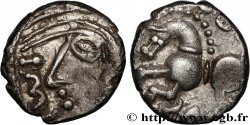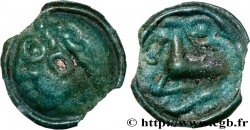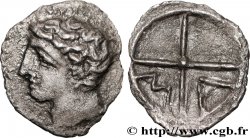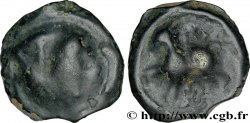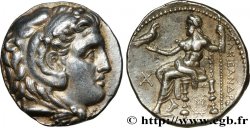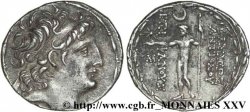bga_293654 - GALLIEN - BELGICA - SEQUANI (Region die Besançon) Obole à la croix, MASO tête à droite, type du coin d’Arbois
90.00 €
Menge
In den Warenkorb

Type : Obole à la croix, MASO tête à droite, type du coin d’Arbois
Datum: c. 80-50 AC.
Metall : Silber
Durchmesser : 9,5 mm
Stempelstellung : 3 h.
Gewicht : 0,45 g.
Seltenheitsgrad : R2
Kommentare zum Erhaltungszustand:
Petit denier assez mal venu, mais encore bien identifiable. Patine grise et fortement cristallisée
N° im Nachschlagewerk :
Vorderseite
Titulatur der Vorderseite ANÉPIGRAPHE.
Beschreibung Vorderseite Tête stylisée à droite, la chevelure formée par des esses ; grènetis.
Rückseite
Titulatur der Rückseite M/A/S/.O. (LE A EN FORME DE DELTA).
Beschreibung Rückseite Croix cantonnée avec une lettre dans chaque canton ; listel.
Kommentare
Avers stylisé, comme le bga_264677 de CELTIC V, mais avec la tête à droite. Avec le bga_293650, ce sont les deux premiers exemplaires que nous avons avec le Delta dans le 1er canton (soit MASO).
Il existe de nombreuses variantes pour ces très rares oboles ! Le droit peut avoir une tête à droite ou à gauche, avec ou sans la croisette dans la chevelure. Le revers peut aussi présenter plusieurs combinaisons de lettres ; MASO ou MAOS.
Selon l’étude qui a été réalisée à l’occasion de la publication du coin d’Arbois, cet exemplaire avec la tête à droite et la légende MASO appartiendrait à la classe I, variante plus rare au profil à droite, mais avec la légende MASO et non pas MAOS comme c’est le cas sur le coin.
L’attribution à l’Est de la France, autour du Jura est probable au vu de récentes découvertes. Il semble qu’il y ait eu des confusions entre les monnaies de ce type, et les imitations de Marseille épigraphes MSAO, émises dans la vallée du Rhône ou plus précisément par les Allobroges (cf. DT. 3173).
En recherchant des références pour cette obole, on se rend compte qu’il s’agit d’un monnayage très rare et curieusement absent de la plupart des publications et des collections publiées.
Ce type semble indirectement copié sur les oboles de Marseille. Il présente aussi certaines similitudes avec les oboles à la croix des Volques Tectosages
.
Stylized obverse, like bga_264677 of CELTIC V, but with the head on the right. With bga_293650, these are the first two examples that we have with the Delta in the 1st canton (i.e. MASO).
There are many variations for these very rare obols! The right can have a head on the right or on the left, with or without the cross in the hair. The reverse can also have several combinations of letters; MASO or MAOS.
According to the study which was carried out on the occasion of the publication of the coin d'Arbois, this example with the head on the right and the legend MASO would belong to class I, a rarer variant with the profile on the right, but with the legend MASO and not MAOS as is the case on the corner.
The attribution to the East of France, around the Jura is probable in view of recent discoveries. It seems that there was confusion between coins of this type, and the imitations of Marseille epigraphs MSAO, issued in the Rhône valley or more precisely by the Allobroges (cf. D.T.. 3173).
By searching for references for this obol, we realize that it is a very rare coinage and curiously absent from most publications and published collections..
This type seems indirectly copied from the obols of Marseille. It also has certain similarities with the obols on the cross of the Volques Tectosages
Il existe de nombreuses variantes pour ces très rares oboles ! Le droit peut avoir une tête à droite ou à gauche, avec ou sans la croisette dans la chevelure. Le revers peut aussi présenter plusieurs combinaisons de lettres ; MASO ou MAOS.
Selon l’étude qui a été réalisée à l’occasion de la publication du coin d’Arbois, cet exemplaire avec la tête à droite et la légende MASO appartiendrait à la classe I, variante plus rare au profil à droite, mais avec la légende MASO et non pas MAOS comme c’est le cas sur le coin.
L’attribution à l’Est de la France, autour du Jura est probable au vu de récentes découvertes. Il semble qu’il y ait eu des confusions entre les monnaies de ce type, et les imitations de Marseille épigraphes MSAO, émises dans la vallée du Rhône ou plus précisément par les Allobroges (cf. DT. 3173).
En recherchant des références pour cette obole, on se rend compte qu’il s’agit d’un monnayage très rare et curieusement absent de la plupart des publications et des collections publiées.
Ce type semble indirectement copié sur les oboles de Marseille. Il présente aussi certaines similitudes avec les oboles à la croix des Volques Tectosages
.
Stylized obverse, like bga_264677 of CELTIC V, but with the head on the right. With bga_293650, these are the first two examples that we have with the Delta in the 1st canton (i.e. MASO).
There are many variations for these very rare obols! The right can have a head on the right or on the left, with or without the cross in the hair. The reverse can also have several combinations of letters; MASO or MAOS.
According to the study which was carried out on the occasion of the publication of the coin d'Arbois, this example with the head on the right and the legend MASO would belong to class I, a rarer variant with the profile on the right, but with the legend MASO and not MAOS as is the case on the corner.
The attribution to the East of France, around the Jura is probable in view of recent discoveries. It seems that there was confusion between coins of this type, and the imitations of Marseille epigraphs MSAO, issued in the Rhône valley or more precisely by the Allobroges (cf. D.T.. 3173).
By searching for references for this obol, we realize that it is a very rare coinage and curiously absent from most publications and published collections..
This type seems indirectly copied from the obols of Marseille. It also has certain similarities with the obols on the cross of the Volques Tectosages







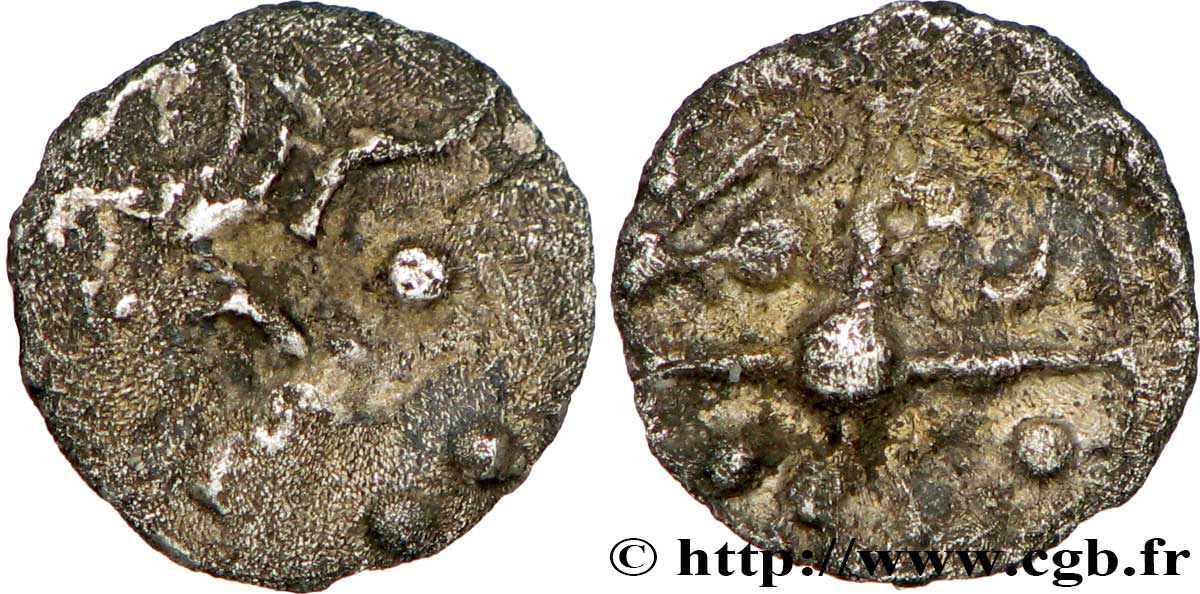
 Berichten über einen Fehler
Berichten über einen Fehler Die Seite drucken
Die Seite drucken Teilen meiner Auswahl
Teilen meiner Auswahl Stellen Sie eine Frage
Stellen Sie eine Frage Einlieferung/Verkauf
Einlieferung/Verkauf
 Details
Details